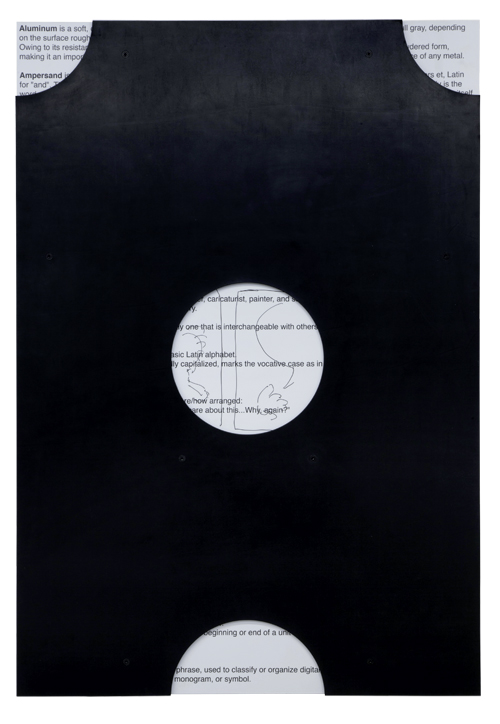Benjamin Hirte
Form and functionlessness
Form and functionlessness

I already wrote about Benjamin Hirte’s art two years ago. At the time, I tried to locate Hirte’s works (and those of other Viennese artists) in the framework of a text titled Vienna Interiorism (frieze d/e No. 12, Winter 2013/14) in a kind of Heimo Zobernig/Franz West/Wiener Werkstätte continuum – the endurance of local art history tied to a heightened interest in interior decoration and the applied arts. To my mind, works such as untitled (stool) (2010), a stool constructed from two ant chair seats fitted together, seemed to offer definitive proof of this. Even if this wasn’t altogether wrong, it nonetheless falls short when viewing Hirte’s works from today’s perspective – particularly regarding a good deal of what the artist has done since. But perhaps this is normal in hindsight: meanings are attached and slip off again, are tied to objects and then cut loose. But in Hirte’s case, it goes somewhat further.
A large part of his output seems to cultivate a radically reflective approach to the idea of meaning itself, and particularly its withdrawal. One could also say: an exploration into furnishings and the applied arts has shifted from the furniture store to the home improvement centre. Instead of focusing on thematic systems of meaning, or those pieced together in a stylistically coherent manner (regardless of whether they adhere to the index called ‘art’ or ‘design’), Hirte directs his attention to individual, minimal, frequently isolated elements – letters and signs, fragments and building components. Series suggesting a larger whole are only partially completed, and in individual instances. Like in the case of the wall pieces untitled (O), …(I), and …(A), all from 2015: hole-punched, nearly indecipherable units of an alphabet; rubber letters attached to aluminium sheets printed with long rows of numbers and letters; artefacts of an interface file. Or else: simple everyday objects stripped of their original, utilitarian purpose that become, in the form of grossly enlarged aluminium versions of themselves, objects that are abstract, seemingly lost, and comical – for instance, the keychain untitled (circlip) (2015), or the gigantic pop-tab of a soft drink can, which Hirte has planned for his upcoming exhibition at the MMK Zollamt in Frankfurt. Home improvement center, certainly, but seen through the eyes of Claes Oldenburg.
In terms of material, it’s noticeable how often the artist works with standardized products that are frequently cast, or roughly remodelled but not entirely reworked: double-walled aluminium insulation plates with a black rubber filling, for instance, bent into something akin to half-open boxes standing around Emanuel Layr Gallery in Vienna in 2014; evidently stackable, untitled works of art in a solo show that also remained untitled; or the super-simple Strap Band, a metal strap enlarged to gigantic proportions and cut from aluminium, with round holes one would ordinarily drive nails or screws through to affix things to the wall. In 2015, that work became bereft of its function with a strange dent in the middle, ultimately attached to the wall of Picnic Picnic in Sheffield.

Strap Band says quite a bit about Hirte’s approach: objects are not so much fenced in and caught in meanings; instead, they function more as a language in their own right – through couplings and connections. At the same time, however, they are analogue, and so they don’t quite obey the digital structure of a randomly recombinable set of abstract elements. Strap Band signifies connectivity, the possibility of attaching something (meaning) to something else (support) – the possibility of bringing things together, and keeping them there. But this happens at the price that the elements themselves depart into a strangely lost and disparate abstraction. The sense of loneliness these objects convey – sad, comical and dull – issues from precisely this ambiguity.
Concrete separation and exaggeration of objects that in themselves express little but hint at flexible and even promiscuous connectivity: this game of deception resides in many of Hirte’s works. Take the unbelievably simple objects called untitled (hinge series) (2014) – hinges with aluminium sheets attached, in which a hole has been punched here or there. A functional object without function, albeit with meaning: that’s a hinge. But it’s meant as a link. Or take, as a final example, the works untitled (tags) (2014) – plywood sheets covered in a layer of cement that lean against the wall or protrude from it, covered in strange cut outs, small holes and larger ovals, some of which seem to com- bine to form cartoonish faces. These objects, difficult to decipher and oddly situated between picture and sculpture, are in fact grossly enlarged ‘tags’ – in other words signs, or to be more precise: those little pieces of cardboard affixed to wares. Normally, these tags carry product information, instructions, a list of materials (in short, the ‘work description’ of the product); at the same time, they’re also a kind of display. In Hirte’s enlarged versions, there is neither information nor a product attached. What remains is residue, coded several times over, and use-less in the end. Which is pretty close to a definition of a work of art.
Translated by Andrea Scrima

















